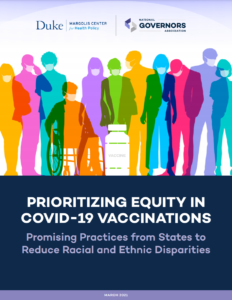Promising Practices from States to Reduce Racial and Ethnic Disparities
introduction
Systemic inequities underpin disparities in COVID-19 risk and disease burden among historically marginalized populations across the United States. Black, Latinx, and American Indian populations have borne a disproportionate burden of the pandemic including in risk of exposure, transmission, case rates, severity of illness, and mortality, and those inequities are now extending to disparities in COVID-19 vaccination rates. Despite increased risk and disease burden, data from states reporting race and ethnicity show Black and Latinx populations have received vaccinations at lower rates compared to their shares of total COVID-19 disease burden and population.
In contrast, non-Hispanic White populations are over-represented in COVID-19 vaccination rates compared to their share of total COVID-19 disease burden and population. National data reported by the Centers for Disease Control and Prevention (CDC) shows Black and Latinx individuals represent 7.2 and 7.4 percent of total COVID-19 vaccinations, respectively, as of March 25, 2021. These disparities in COVID-19 vaccination rates illustrate an additional COVID-19 health inequity. Noting the role of systemic racism in COVID-19 disparities, the Biden Administration has detailed priorities to ensure equitable access to COVID-19 vaccines across the country and Governors continue to refine efforts to center equity in state vaccination plans. In a prior qualitative analysis of publicly available state and territorial COVID-19 vaccination plans, the Duke-Margolis Center for Health Policy and the National Governors Association found some states planned to adopt equity as a guiding principle, established committees to determine equitable allocation, and initiated or strengthened community engagement, including with tribal communities, among other approaches to improve vaccination rates among historically marginalized populations. In addition, many Governors have appointed health equity taskforces, including state and local agencies and community partners, to plan and reassess COVID-19 response efforts.
As vaccine availability increases and eligibility expands to meet the goal of vaccinating as many individuals as quickly as possible, prioritizing equity along with speed will be essential to ensuring access to and uptake of COVID-19 vaccines across all populations. In this brief, we highlight state-level strategies that aim to improve reporting of race and ethnicity data in vaccine distribution, use data to plan for allocation and distribution according to need, overcome systemic inequities that lead to differential access to COVID-19 vaccinations, and build trust in COVID-19 vaccines and COVID-19 vaccination processes. Governors may consider these strategies as ways to increase equity as they expand eligibility for COVID-19 vaccinations to all population groups.
Key Takeaways:
- State and federal leaders need to strengthen existing collaborations in all three areas – data, access, and community leadership – to meet the goals of equity and speed.
- Reporting race and ethnicity data is a foundational step to identify allocation and distribution patterns and reassess allocations to reach historically marginalized populations, who are bearing a disproportionate burden of the pandemic.
- Differential access to COVID-19 vaccination sites is a root cause of disparities in COVID-19 vaccination rates.
- Strategies that reduce or remove systemic barriers to access, support community leadership to facilitate informed decision-making, and increase data collection, reporting, and use to identify and reassess allocation patterns will help states vaccinate as many people as quickly and as equitably as possible.













